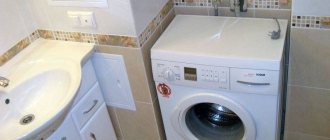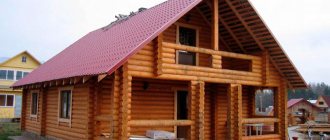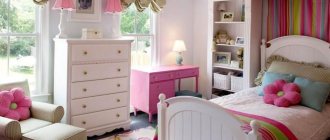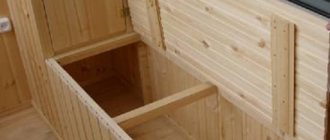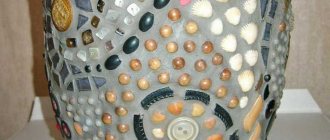- November 10, 2018
- Country house
- M-aria Shh
Since ancient times, people have gone to the bathhouse to thoroughly cleanse and warm their bodies. Today it is also a place for relaxation, communication with friends and psychological relief. To make it pleasant to be there, it is important to carefully think through and arrange everything. This publication will tell you how to arrange a bathhouse inside with your own hands. The photos presented as an example will demonstrate how this can be done.
Material selection
The interior decoration of the bathhouse should be practical, durable, resistant to moisture and high temperatures. Therefore, special requirements are put forward for materials.
- Heat capacity. First of all, the steam room and washing room should have this property, because it is there that the temperatures are highest. For example, if the bench gets very hot, you can easily get a red mark on your body or even a burn.
- Durability. Such a structure is built not for one season, but for many decades. Therefore, there is no need to save on finishing for arranging a bathhouse both inside and outside.
- Hygiene. The body will be in constant contact with the material, and it needs to be cleaned periodically. Therefore, the finish should not only be easy to clean, but also not absorb dirt and chemicals.
- Strength. This quality is related to the previous one. If the material is fragile, it will soon develop potholes, cracks and other defects. Dirt will accumulate in them faster, and washing it out is more difficult, and sometimes even impossible.
- Safety. Materials must not emit harmful substances, toxins, volatile compounds or cause allergic reactions.
- Aesthetics. This is a requirement for a beautiful finish, but it is very subjective. The bathhouse should be created taking into account personal preferences and taste preferences.
When the requirements for interior decoration are clear, you can move on to considering specific materials.
Lining
It is a well-processed, narrow and tightly fitted board. This is an inexpensive, practical and attractive option. That is why lining is very often chosen for arranging a bathhouse inside with your own hands. The photo below shows an example of design using this material.
Lining has a number of advantages that are valued not only by ordinary buyers, but also by experienced builders. Among them the following can be noted.
- Safety and environmental friendliness. The composition does not contain radioactive particles or toxic substances.
- The material allows the walls to “breathe”. Thanks to this, the level of humidity indoors is regulated, and the development of mold, mildew, and condensation is prevented.
- The lining is installed very simply (the strips are inserted into each other). For this type of work you do not need to have special skills, so even a beginner can handle it.
- Affordable price compared to alternative options.
When purchasing, you should pay attention to the types of grooves. It is better to immediately abandon the “quarter” and “rabbet” options. It is recommended to give preference to the tongue-and-groove profile. This design does not move over time, which means that the tightness of the joints and tightness are not compromised.
The lining can be made from various woods. But coniferous species are absolutely not suitable for arranging a bathhouse inside. They often release resin due to hot steam.
Covering the baths with clapboard
Covering a sauna with clapboard is not something long and requires a lot of experience.
It is recommended to break down all work into stages, which allows you to distribute working time as efficiently as possible and control the timely completion of all previously assigned tasks.
- The first stage, of course, will be preparatory work;
- The second is the creation of a wooden frame for subsequent fastening of the lining strips;
- The third stage is the installation of insulating materials and the installation of the lining itself.
- The fourth and final step can be considered finishing the lining itself, applying a protective layer.
Antiseptic coating for wood - a real opportunity to extend the life of wood finishes
Preparatory work
Before immediately starting work on decorating the walls of the bathhouse with your own hands, it is recommended to carry out preparatory work, which most often includes preparing the walls and ceiling of the bathhouse for further work.
If there are sufficiently deep differences on the walls, at the rate of no more than 2 mm per 1 meter, then work should be done to level the surface. In this case, you can use plaster or putty - the most optimal and inexpensive option.
To increase the level of resistance and durability of the building, as well as to eliminate the possibility of fungus and mold appearing on the walls, most experts recommend applying special protective agents to the walls.
Afterwards, work begins on installing communications, which can include:
- Electricity supply;
- Water supply;
- Everything that can be easily and quickly hidden using wooden panels.
As the last work at this stage, we can note the purchase of direct lining strips and other fastening materials, in particular we are talking about wooden blocks, hangers, and various heat-insulating materials.
The photo shows high-quality installed wiring in the bathhouse
Note!! We recommend that you bring the purchased lining inside the bathhouse and leave it there for two days; this will allow the material to age, thereby getting used to the climate of the room itself, eliminating the appearance of cracks and chips during further use of the finishing material.
Installation of sheathing
The instructions below will help you understand how to choose the right lathing and how to subsequently lay thermal insulation material between the beams.
To create a frame for the subsequent installation of the lining, you should use only a wooden block, the optimal size is 20x50 mm. When cutting, you can use sizes of 1000 mm in length and 500 mm; also, at your discretion, depending on the type of bath structure itself, you can choose a different ratio of sizes.
Installation of metal hangers on the wall
Afterwards, we install metal hangers; they should be placed at a distance of 30-40 centimeters, while the distance between the rows with beams will be about 40-50 centimeters. We attach the hangers to the wall using dowels. We attach bars for the frame to the pendants.
Laying insulation
Before installing the lining strips on the wall, work is carried out to insulate the bathhouse. Most often, in the process of performing these works, mineral wool is used - as an inexpensive material, but at the same time high-quality and effective, fully meeting modern requirements for creating bath complexes and saunas.
Installation of mineral wool, on top of it a vapor barrier film
On top of mineral wool, it is recommended to install a vapor barrier layer in the form of a vapor barrier film; a wide selection on the market is presented by the ISOSPAN company; these materials help to achieve a comprehensive solution to issues related to the implementation of high-quality heat and vapor barrier of a single room or bathhouse as a whole.
Installation of lining
The process of installing and covering the walls of a bathhouse with clapboard inside can be divided into several main components.
In particular, we are talking about:
- Fastening the lining with galvanized tenon screws. It is recommended to drill holes for self-tapping screws to prevent chipping.
- Start the sheathing process from the most inaccessible place, but remember that the very last board will have to be adjusted both in length and width.
Cladding with clapboard should start from the most inaccessible places
- The corners of the rooms are finished with a special wooden plinth, which is secured with stainless nails. Some experts recommend the use of glue when attaching such elements, which is considered by most to be a waste of material and money, since glue is simply ineffective in rooms with high temperatures and constant fluctuations.
How to properly line a bathhouse with clapboard using nails as fastening material
Block house
It is a lining-type planed board, which in appearance resembles a profiled beam or segments of a rounded log. This material has its advantages. It is natural, environmentally friendly and of decent thickness, which contributes to additional insulation of the structure. In addition, the block house looks very beautiful on the walls, as evidenced by the photo below.
How to arrange a bathhouse inside with your own hands using such material? The boards must be attached directly to the wooden sheathing, and then treated with an antiseptic, which will prevent the development of fungus. Places of contact with heating devices should be insulated with mineral wool.
For a bathhouse (especially for a steam room), a block house of only a certain class is ideal. “A” is a processed surface with no cracks or knots. It is allowed for use. Extra class will be optimal. This means that there is absolutely no damage to the boards. Classes “B” and “C” are absolutely unacceptable for performing work inside a bathhouse.
Imitation of timber
This material looks like a natural board on the walls, but is much more practical to use. In addition, it is an inexpensive, environmentally friendly material that provides additional heat and sound insulation.
How to arrange a bathhouse inside with imitation timber with your own hands? There are some peculiarities in its installation. First you need to remove it from the package and leave it open for several days. At this time, you can prepare the walls: clean them from dust, prime them and cover them with lathing. Only after this is it recommended to install imitation timber. If it is necessary to increase resistance to an aggressive environment, then the finish should be coated with a protective varnish.
Tile
Tile is used most rarely for interior decoration of a bathhouse. Although this is a highly practical material, it is easy to care for, resistant to moisture and has a long service life. The main thing is to choose a tile that is ideal for the conditions of the steam room. Glazed models tolerate sudden temperature changes well. Non-enamelled and porous tiles are absolutely not suitable. In addition, the surface should not be smooth, but rough, so that it is safe to stay and wash in the bathhouse. The tiles are installed using the same technology as in other rooms.
The shape of the tile can be either classic (rectangle, square) or non-standard (rhombus, hexagon, circle, etc.). You can come up with a lot of options for how to arrange a bathhouse inside. The photo below is one example.
Characteristics of wood used for finishing steam rooms
The comfort and safety of its visitors depends on the correct choice of finishing material for the bathhouse. Traditionally, natural wood is used - an environmentally friendly and affordable raw material. Bath culture originated a long time ago and since then a lot of knowledge has accumulated about the properties of this or that wood. Each of them has special characteristics and healing qualities that allow you to create a unique microclimate in the steam room. There are many options for wood that can be used to decorate a bathhouse. These include the familiar linden, alder, larch, birch and exotic Abacha oak. Let's figure out how they differ and which breeds are better suited for a particular bathhouse.
African abacha oak
The African Abacha oak is a member of the malvaceae family. It is also called abashi, ayous, samba. This tree is capable of reaching gigantic sizes - the height of its trunk can reach up to 40 m, and its diameter up to 3 m. Abacha has durable wood with a dense and even texture. It retains its shape well and is easy to process due to the absence of knots - the crown is located at the very top of the tree. This is an expensive material, comparable in cost to mahogany, but its remarkable qualities allow it to remain very in demand and popular.
Properties of Abacha wood. The main advantage of this material is its low ability to conduct heat. Thanks to this, rooms with such finishing will remain cool in summer and warm in winter. In a bathhouse, this feature manifests itself as follows: the boards practically do not heat up, so it is impossible to get burned while sitting on an abacha shelf. In contact with the human body, wood takes on the temperature of his body. In addition, it does not release resinous substances, even with strong heating.
The positive characteristics of African oak do not end there. The list of its advantages includes resistance to:
- deformation during drying;
- mechanical damage;
- shrinkage;
- color change with prolonged use;
- high humidity - the boards remain dry even at a humidity of 12%. They practically do not absorb water, even from the end sides
Abacha oak is easy to process, which can be done with your own hands. Thanks to its dense structure, cracks do not form in it when driving nails, and the screws are screwed in well and held securely. Lumber can be easily glued and tinted. In the interior they go well with other types of wood.
Abacha wood is an expensive commodity. If you decide to decorate your bathhouse with this particular material, be careful - choose a really high-quality product.
Cedar
Noble cedar is the choice of aesthetes. Finishing from this material looks expensive and impressive. Light ocher-yellowish cedar wood has a smooth and beautiful texture. The annual rings and resin ducts are clearly visible on it. Cedar is a natural antiseptic. The finish made from its wood makes the air sterile and cleanses it of harmful bacteria. Essential oils have a beneficial healing effect on human health and fill the room with a wonderful pine aroma.
The wood has a high density and at the same time softness, which makes it easy to process and is not afraid of moisture, temperature changes, exposure to fungus and insects.
The disadvantages of the material include its high cost and insufficient aroma persistence. It is noted that the smell disappears within six months after the start of use of the bathhouse.
Alder
Alder wood is very popular. It has one of the most important qualities for a steam room - it does not heat up too much. Thanks to this, you can ensure that you and your loved ones will not get burned when touching wooden surfaces. Immediately after cutting, the wood has a light shade that magically changes upon contact with air. It acquires a reddish tint, which makes it similar to more valuable species - cherry, walnut. The unique aroma of alder is reminiscent of the smell of cognac, and like the latter, its richness and nobility only intensify over time.
Finishing made from this wood is excellent for a bathhouse, since it is not afraid of humidity and temperature changes. No resin is released from it, and this is very important for a hot room. The only difficulty is to choose high-quality material - smooth, defect-free alder paneling at reasonable prices.
Larch
Reddish larch wood contains many substances beneficial to the human body. This material has high mechanical properties and can honestly serve for decades. Elevated temperature and humidity are not scary for her. Among the disadvantages of larch is the difficulty in processing - due to the large number of knots and low thermal insulation ability.
The cost of wood is quite adequate to its characteristics. The long service life will more than pay for the investment made.
Linden
In Russia, this tree has long been revered for its beneficial properties. Its fragrant, pale pink wood is very popular and is often used to decorate baths. It compares favorably with other breeds with its even structure and characteristic shine. Linden is easy to process because it is a soft wood and does not create cracks during the process. The relatively low density of the material increases with decreasing humidity.
A steam room decorated with linden wood has healing properties and is recommended for the prevention of diseases of the respiratory organs, in particular the lungs.
A humid environment may cause the wood to gradually change color, but this will not affect its strength and durability. If handled carefully, the linden finish will give you many years of enjoyment. The cost of the material cannot be called too low, but it is not too high either. Therefore, it is suitable for most bath lovers who want to set up their own steam room.
Aspen
Aspen occupies a leading position among Russian deciduous species and is second only to birch. Its white wood with a subtle bluish-greenish tint has a uniform structure, softness, and straight grain. Lining and other lumber made from aspen are light in weight and can be easily processed - cutting, turning, and are resistant to abrasion. Due to their strength, durability, and excellent ability to retain heat, they are widely used in the improvement of baths and saunas. Aspen shelves do not overheat and do not burn.
The main advantage of this material is that being in water for a long time does not damage its integrity and does not “lead” after drying. That is why aspen was often used in the manufacture of well logs.
Birch
Birch wood has a pinkish or yellowish with white tint. Old trees boast a light brown cut color with a soft, luminous sheen. Winding fibers combined with dark inclusions form an interesting pattern. Birch has a homogeneous, dense and elastic structure. Thanks to this, it is easy to process not only with machines, but also with ordinary hand tools.
A bathhouse decorated with birch boards helps relieve fatigue and feel a surge of energy. Regular visits to such a steam room increase the body's resistance to colds.
Unfortunately, this material will not last long in “wet” rooms, since high humidity and heat are extremely harmful to it. It would be much better suited for a rest room. You can extend the life of birch trim using special treatment that will prevent rotting.
Ash
Ash is the owner of hard, heavy and strong wood. The light brown heartwood with an olive-brown tint gradually blends into the yellowish-pinkish sapwood. Large vessels make the wood texture very impressive and beautiful. When dyed, the fiber pattern becomes even more expressive and contrasting. The material is highly resistant to moisture and is characterized by moderate drying. It lends itself well to processing and polishing.
Picturesque texture, high strength, hardness, low water permeability, resistance to deformation, high impact strength, resistance to fungus and insects. All these qualities allow ash to stand on the same level as oak and even surpass it in some respects. It is these properties that make it possible to widely use its wood in the production of building materials, which are very useful when arranging a bathhouse. This is eurolining, imitation of timber, logs, in other words - a block house.
Features of floor and ceiling arrangement
Experts recommend covering both the floor and the ceiling (as well as the walls) in the bathhouse with wooden material. It's easier to work with and much safer. It is preferable to choose linden, aspen or cedar from wood.
How to arrange a ceiling inside a bathhouse with your own hands? It must be remembered that hot air will accumulate under it. Therefore, it is better not to use coniferous species. There is a high chance that sticky and melted resin will drip onto your head. Practice shows that lining is more suitable for ceilings.
When laying the floor, special attention should be paid to water drainage. It must be correct, otherwise a “swamp” may appear under your feet. For these reasons, closer to the drain hole, the floor should have a slight slope so that the water drains naturally. You can install a siphon with a lid - it will protect against the appearance of unpleasant odors. A board made of cork boards or wooden boards should be laid directly on the floor. Oak is an excellent material with good moisture resistance and high strength. But this breed is not suitable for a bathhouse floor, since the feet will slip on such a surface, which is very dangerous. Many people prefer coniferous trees. With constant care, this material will last quite a long time.
Interior finishing options
Arranging a bathhouse inside with your own hands is not an easy task. The choice of finishing option will depend on the purpose of the room. After all, each room is specific in its own way and requires special conditions.
- Steam room. They spend enough time here to relax and thoroughly cleanse the body. Materials must be safe, environmentally friendly and resistant to heat.
- Washing room. For it, you should choose the most practical materials that are not afraid of water and high humidity.
- Waiting room. It is intended for undressing, but at the same time it can also be a relaxation room for gatherings with friends. It should be warm and comfortable here.
It is worth studying in more detail the design features of the above-mentioned premises.
Selection of finishing material
Decorating the inside of a bathhouse with your own hands is done mainly using wood. At the same time, it is recommended to use different types of wood species for different rooms.
To decorate the steam room, it is best to choose linden. Lining with linden will guarantee that you will not accidentally burn yourself while in the bathhouse, since this material does not have the ability to overheat so much .
Other durable, quality cladding options include:
- birch;
- aspen;
- poplar.
The cheapest wood for cladding is pine, but it is better not to use it for a steam room, since it contains resins. When exposed to high temperatures, they are released and appear on the surface of the skin.
All species used for cladding have the ability to dry quickly and perfectly; different types of wood have their own beneficial properties for the human body. For example, thanks to linden, a person receives positive energy, and aspen relieves negative emotions and protects against diseases.
The interior decoration of a sauna or bathhouse cannot be done with wood boards or linoleum, especially in the washing area or steam room. Such materials have a negative impact on health.
When heated, slabs made of mineral wool, fiberboard or chipboard are toxic and fire hazard; when they absorb moisture, they swell greatly. When heated, linoleum releases harmful components, rots quickly and is not suitable for high humidity.
Prohibitions on the use of such materials apply only to steam rooms and adjacent rooms with high humidity; this does not apply to rest rooms. Since their humidity is low and the temperature is optimal, this will not cause the release of poisons.
Steam room
Usually there is quite a small space in it, so difficulties may arise if you need to arrange a bathhouse inside with your own hands. The photo just above shows a successful example of design. Everything is simple and tasteful, and almost every meter is used. This is how it should be in a steam room.
In this room, it is recommended to cover the walls, ceiling and floor with natural wood or clapboard. They are safe, aesthetically pleasing and allow for thermal insulation of the base. A linden tree that remains beautiful for a long time and does not overheat would be ideal. As already mentioned, coniferous species are absolutely not suitable. Also, repairs in the steam room cannot be made using linoleum, chipboard, fiberboard and wood boards. Such materials are fire hazards, release toxins into the air, and swell and rot when exposed to moisture. For walls, you can use wood and brick at the same time, as in the photo example.
If you want to make the inside of the bathhouse more comfortable and finish the stove, then you should definitely use only those materials that are resistant to high temperatures. The best option would be natural stone or its artificial analogue. Ordinary brick will also work. It fully meets the necessary requirements. If it is not satisfied with its aesthetic qualities, then cladding with decorative bricks is allowed.
The interior of the steam room usually contains benches, loungers and shelves. All furniture should preferably have rounded corners.
Design, decoration and equipment of premises
The choice of design depends on the preferences of the future owner, the size, nature and purpose of the functional areas inside the bathhouse.
Steam room design
The interior of the steam room should ensure the comfort and safety of visitors. The accessibility of elements, straight and rounded lines of its filling will certainly make the room as comfortable and ergonomic as possible.
The main space is given over to shelves. To make them, narrow wooden planks are used, which are stuffed at a certain pitch. Gaps are necessary for proper air circulation and quick drying of wet boards. In addition, the gaps make the structure more elegant, light and airy.
It is better to organize lighting using small built-in or pendant lamps with soft diffused light. Lampshades made of wooden slats are ideal for the decoration of the room.
A stove-heater is an essential element of a steam room. There are many variations in its design and location. The choice and placement of the heater depends on the size of the room, its configuration, and the location of functional areas. If the heater must heat two adjacent rooms, then it must be placed between them. In a polygonal grill sauna, the stove is installed in the middle, and the chimney is led out through the center of the roof.
The decoration of the steam room will become more impressive if you alternate slats from different types of wood. Aspen inserts become even darker over time, so the wooden mosaic will become more contrasting and more expressive. Inserts made of brick, glass or marble, placed in hard-to-reach places, perfectly complement the interior.
Oven - types and selection criteria
Sauna stoves can be classified according to various characteristics. Firstly, based on the material of manufacture:
- brick - a traditional solution, quite expensive to implement and maintain. Such stoves retain heat for a long time, can heat large rooms and are relatively safe. Their disadvantages are that they take a long time to warm up and take up a lot of space in the steam room;
- metal made of steel - their advantages are small size, simple installation, high heating rate. The other side of the coin is that they are not powerful enough for large steam rooms, they cool down as quickly as they heat up, so you need to constantly maintain combustion, they do not have a sufficient level of fire safety, and you can get seriously burned if you come into contact with them.
- metal ones made of cast iron are strong, durable stoves with thick walls, which have approximately the same characteristics as steel ones.
Another sign of sauna stoves by which they can be classified is the fuel on which they operate. Heaters can operate on wood, gas and electricity.
When choosing a stove, you need to focus not only on the material and type of fuel. The most important criterion is the power of the device. It must correspond to the volume of the room. Otherwise, it may happen that a stove that is too powerful will heat the air and not the stones. And if it is too weak, you will have to work at the highest speed to warm up the steam room. In such conditions it will quickly fail.
Stones - which ones and how to choose
The quality of the stones directly affects the uniformity of heating of the steam room and the quality of the steam. This indicator depends on the type of stones, their heat resistance, size, shape, and location in the heater. The best stones for sauna stoves are those that were formed as a result of the solidification of magma. They have been tested at extreme temperatures and therefore have unsurpassed heat resistance. When you hit such a stone with a hammer, a ringing sound should be heard. If the sound is dull, this indicates that you have sedimentary rocks that are absolutely unsuitable for a sauna stove. For use, you can take the following types of stones: gabbro, porphyrite, basalt, crimson and white quartz, soapstone, soapmagnesite, jadeite.
Decoration of shower/washroom
Unlike the steam room, where it is not recommended to use conifers, in the wash room they will be most welcome. The resinous walls can easily withstand the humidity that reigns in this room.
Another finishing option is tile, marble or porcelain stoneware. The floors can be tiled with rough tiles, rubber mats or a wooden grate can be placed on top. You can combine materials and use tiles only in the shower area.
The washing room can be organized as a separate room, or located directly in the steam room. In this case, you need to ensure the location of different zones on two levels - place shelves at the top, and make a shower below, separated by a blank or transparent partition.
It is necessary to arrange ventilation in the washing compartment, which will help moisture evaporate in a timely manner and prevent rotting of the wooden finish.
If the room is small, a shower can successfully replace a bucket of cold water. It will be useful for contrast dousing to refresh yourself after leaving the steam room. In addition to such a bucket, you should put benches for clothes, hygiene products and accessories.
The modest dimensions of such a room do not allow installing a large chandelier. Therefore, it would be more correct to prefer wall spots or spotlights.
If there is enough space, the functionality of the washing room can be seriously expanded. Here you can install a miniature swimming pool, a massage table, and a stylist’s chair.
Arrangement of the rest room
If you have managed to allocate a room in the bathhouse where you can gather with friends or indulge in relaxation, do not forget to carefully consider its improvement. The rest room is a corner that can be filled with home warmth and comfort. Its interior should support the overall design idea and be consistent in style with the other areas of the bathhouse. Therefore, you need to make sure that every detail fits harmoniously into the overall style and decorates the room.
In this room it is better to avoid large windows. There is no need for an abundance of sunlight and drafts here. For curtains, you can choose roller or narrow Japanese models. And bamboo blinds will support it.
If the recreation room is not also a formal dining room, you can do without a central chandelier. The dim light of spotlights will be quite enough. Furniture should be selected depending on its purpose and the size of the room. This could be a huge reception table or an area by the fireplace with soft sofas and cushions. If space allows, organize small shelves for storing oils, brushes, washcloths, caps, gowns and other bath accessories.
Everyone chooses the content of the rest room in accordance with their interests. Some people need a huge plasma, others will prefer to surround themselves with their favorite books, and still others will want to create a modern gaming area with a pool table or air hockey.
Washing
It would seem like an ordinary room, but when arranging it, you can also “take a walk.” For example, this part of the bath can be combined with a steam room and completely covered with wood. The advantage of this design is that mold will die under the influence of high temperature. If the washing area is separate, it is necessary to ensure sufficient air circulation. In this case, it is optimal to use coniferous wood, which can withstand high humidity.
If simple maintenance is a priority, then it is better to decorate this room with tiles, which are practical, durable and wear-resistant. The main thing is that its surface is rough. It is worth noting that tiles go well with wood. This is well demonstrated by the photo located just above.
The arrangement of the bathhouse inside should be completed by arranging furniture and adding other details. Sun loungers, benches, shelves and all kinds of hangers will be useful here. Some people make a full shower for convenience.
Choosing the right wood
It is important to carefully select wood for crafts. It must have a perfectly clean surface: without fungi, areas of rot, or obvious structural defects. In different rooms of the bathhouse there are different conditions of temperature and humidity, and only selected wood is able to withstand these difficult conditions for years. This is especially important for items that will be used in the steam room (wooden tubs, mugs, buckets).
To use items in the steam room, you should choose low-density wood, such as linden and alder.
The fact is that low-density material reduces the level of thermal conductivity of the product, and it can be safely picked up in the steam room. But for the decoration of the washing room it is better to choose denser wood. In both cases, it is desirable that the wood has a high content of resins, which increase its ability to withstand high humidity.
For wooden crafts I use the following types of wood:
- aspen;
- Linden;
- beech;
- alder;
- maple;
- pine.
Advantages and disadvantages of some types of wood used for making various bath crafts
| Breeds | pros | Minuses |
| Linden. | Good in the absence of viscous resin. This material is resistant to moisture and is able to absorb steam without negative consequences for appearance. The soft structure of linden can be easily processed by hand, and crafts made from it are distinguished by their low weight and low level of thermal conductivity. Another plus of linden is that it is resistant to high humidity, which allows you to use items made from it in a steam room. | The disadvantage of this wood is that over time, crafts made from it become dark, which not everyone likes. Therefore, linden is recommended to be used to create mugs, buckets and various wooden basins for baths. |
| Beech. | It is often used for bath crafts, as it is convenient to plan and process on a lathe. | But it is characterized by a low level of moisture resistance, as it is subject to severe warping from moisture. Therefore, it is better to place beech crafts in the dressing room. Even if you plan to keep them in rooms with low humidity, it would be a good idea to additionally treat the surface of the finished products with special protective oils and wax. |
| Alder. | It is considered a light and soft wood with a sticky texture. It is easy to process and sand, and alder crafts are famous for their velvet surface, very pleasant to the touch. | Not durable. |
| Maple. | It produces objects with a clean and smooth surface that is easy to process and tint. | But this wood is difficult to cut, so you will have to put in a lot of effort. |
| Pine. | Coniferous wood impresses with its availability and affordable price. She smells pleasantly of resin. | It is precisely because of the abundance of resin that it is inconvenient to work with. It can damage the paint layer, dull and clog cutting tools. |
In addition, pine has a striped structure, which may not be suitable for every product.
Waiting room
The materials in this room should retain heat and not be afraid of moisture. The tiles are completely unsuitable due to the feeling of cold. Any wood will be optimal here, because it retains heat and heats up quickly. In addition, the natural material has a pleasant aroma that has a calming effect on a person. This is especially true for the dressing room if it is additionally used as a rest room. The design of the walls using wicker or bamboo weaving looks original. This decor is practical, durable and incredibly beautiful. Another unusual option can be seen in the photo below. Setting up a bathhouse inside with your own hands in this way is not difficult, but very expensive. This is a full-fledged living room with all amenities.
Decor options and materials for production
Often you will not see many metal or plastic products in a Russian bath or Finnish sauna, since traditionally the steam room is considered the kingdom of wood and other natural materials. Experts even try to select various mugs, scoops, tubs, buckets and other bath utensils from wood. There is a completely logical explanation for this, other than a purely aesthetic one. In a steam room, the hot air quickly heats up the metal and can burn a person. And plastic, upon reaching a certain temperature threshold, begins to lose its solid structure and release hazardous substances into the air. A compromise option could be heat-resistant plastic, but it is not suitable for every bathhouse interior design. But the tree will never burn and, under the influence of temperatures, releases beneficial phytoncides and a subtle woody aroma.
With the help of wooden crafts you can even achieve a healing effect in the bathhouse.
At high temperatures, some types of wood produce resins and essential oils. For example, various objects made from coniferous trees have a beneficial effect on the functioning of the respiratory system. They are also able to have a calming effect on the nervous system, strengthen the hair structure and increase blood microcirculation in the capillaries located near the skin.
It is good to purchase wooden crafts and decorative items for the bath, made from natural wood, for practical reasons. Such products are easy to restore, which will have to be done after some time. Proper impregnation and processing of wood before creating a decorative element for a bathhouse will help to extend their service life.
The following crafts and decorative elements are most often found in the bathhouse:
- panels on the walls;
- carved door handles;
- decorative figures;
- signs;
- dining utensils.
Other natural materials that are also found in the design of baths (although not as often as wood) are straw and birch bark. The latter is most often used to decorate the rest room to make tubs, various boxes and caskets, stylized in antique style, Russian bast shoes. It is quite difficult to make such products yourself, without having experience working with birch bark. And ready-made jewelry is inexpensive. They can be used to decorate a relaxation room, but it is better to keep them away from the wash room or steam room.
Bathhouse straw is most often used to make various decorative figures designed to emphasize the traditional Russian design style. Common options for straw figurines are images of birds, horses, female and male characters, and brownies. Straw is quite easy to work with, and anyone can make a few simple straw crafts for a bathhouse with their own hands. It is customary to decorate walls and shelves in the rest room with these decorative elements, where a normal level of humidity is maintained.
Features of lighting installation
Any bathhouse (even one built according to all the rules) is a potentially dangerous structure. Because there is always a possibility of fire and electric shock. How to arrange lighting in a bathhouse correctly? In fact, there are few rules here. The voltage should not be higher than 12 V. Lamps must be chosen those that have moisture-proof housings. The ideal solution is light guide lighting devices. Of course, they are expensive, but they are completely safe. In addition, with their help you can recreate beautiful effects.
Design options
- Russian style. Perhaps it is the most popular in the design of bath rooms. The main components are plank walls and floors, laconic wooden benches and, of course, a massive, welcoming table made of wood. The interior should be complemented with an embroidered tablecloth and other various little things in the Russian style (dishes, basins, brooms on the walls, and so on). In addition, the decor will not require large financial expenditures and you can easily do such arrangement of the bathhouse inside with your own hands. The photo below shows a typical example of Russian style.
- Country. Very similar to the previous style. The design is also “rustic”, but only national elements of other countries are used. Usually there are bright textiles, wood-burning furniture and dishes with rural motifs.
- Loft. He is characterized by negligence in everything. Usually the view is of unfinished walls with visible brickwork. The interior should be furnished with original items. Loft fits perfectly with the following style.
- Modern. How to properly arrange a bathhouse inside in this style? It is necessary to recreate numerous curved lines, add bright colors and abstract images. For furniture, it is advisable to give preference to leather sofas with crooked legs and other luxurious elements.
- East style. It will help give the Russian steam room the features of a hammam. The main material for the walls and floor should be tiles, which are laid in certain patterns. A swimming pool can be installed in the washroom, and the dressing room can be converted into a hookah bar. Bright pillows should be scattered on the floor, and a low table should be placed near them.
How relevant is interior decoration?
So much so that heating a steam room without wooden walls and floors takes a very long time. In addition, condensation will settle on the surface of the walls, and then contribute to the formation of fungus.
Bricks and blocks become completely heated from high temperatures, which is why the user of the “bare” structure can get burned.
With wood, everything is much more reliable and simpler: the breathing mass conducts heat through itself, and therefore never overheats or freezes.
"On a note. If the bathhouse is built from a log house or profiled timber, then there is no need for interior decoration, since solid and massive walls provide the structure with optimal resistance to heat transfer.”
How to arrange a small bathhouse inside?
The main task here is to use the space as efficiently as possible and use the minimum number of necessary details in the interior. Small decor is unacceptable - it will visually reduce the already limited space.
It is worth paying attention to the photo located just above. The arrangement of the small bathhouse inside was thought out to the smallest detail. Here the steam room is combined with a washroom, and the interior has everything you need. An ideal solution for a small room.
So, the interior decoration of the bathhouse should be approached as seriously as possible. It must be practical, durable and safe. You need to arrange the rooms so that they are convenient, comfortable and cozy.
Installation options for lining
To the question of how to line a bathhouse with clapboard, you will receive from each master a unique answer and an almost identical basis of technology, which is used by all specialists offering services for the interior finishing of a bathhouse or sauna using the specified product.
The internal lining of a bathhouse with clapboard technology is usually the same for all its types, the whole point is that the finishing material is attached to a wooden frame, accordingly, there can be no differences in this process.
If we talk about the methods of fastening the finishing material, there are several differences, as well as the options for placing the lining itself on the walls.
If we line the bathhouse ourselves with clapboards, then we should know about the three most popular and widely used methods of placing wooden planks:
- Vertical;
- Horizontal;
- Diagonal.
And as a consequence:
- Combined.
The vertical method requires placing wooden planks against the wall, in a vertical form, the result of which will be perpendicular to the planks of the lining itself. Here the bars are attached horizontally.
The photo shows the vertical, horizontal and diagonal type of lining placement
For diagonal placement of the lining, the bars should be fastened perpendicular to the planks.
As a combined method, you can combine each of the above mentioned options and types of placement of the bar, thus making the interior more interesting and remarkable.
